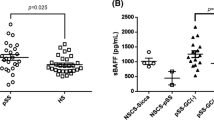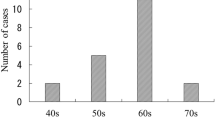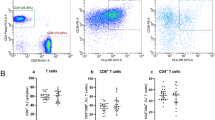Abstract
The purpose of this study was to investigate the characteristics of primary Sjögren’s syndrome (pSS) patients with IgG4 positive (IgG4+) plasma cell infiltration in labial salivary glands (LSGs). Paraffin sections of LSGs from 336 pSS patients were stained with IgG4 and IgG monoclonal antibodies. According to the infiltration of IgG4+ plasma cells, patients were divided and clinical and serological characteristics were analyzed and compared. Based on the infiltration of IgG4+ plasma cells in the LSGs, patients were divided into three subgroups, low IgG4, moderate IgG4, and high IgG4 groups. A negative association between the number of infiltrated IgG4+ plasma cells and the disease characteristics was observed. We found that the higher the IgG4+ expression in plasma cells, the lower the positive rates of serum anti-SSA antibodies, anti-SSB antibodies, antinuclear antibodies (ANA), and rheumatoid factor (RF). Besides, patients from the high IgG4 group had the highest frequency of interstitial lung disease (ILD, 30.6%) and tubulointerstitial nephritis (TIN, 13.9%), but the lowest frequency of leucopenia (13.9%), thrombocytopenia (11.1%), and abnormal thyroidal function (0%). PSS patients with different IgG4+ plasma cells infiltration in the LSGs had distinctive clinical and laboratory characteristics. It may help us to further understand the role of IgG4+ plasma cells in pSS.
Similar content being viewed by others
Avoid common mistakes on your manuscript.
Introduction
Primary Sjögren’s syndrome (pSS) is a chronic autoimmune disease characterized by early and progressive exocrine glandular dysfunction with autoantibody production. The clinical hallmark is the persistent symptoms of dry mouth and dry eyes due to chronic inflammation of the salivary and lachrymal glands. In addition, a considerable proportion of pSS patients developed extraglandular manifestations [1, 2]. According to the American-European Group Consensus (AEGC) criteria (2002) and the criteria of the American College Rheumatology in 2012 (ACR 2012), histological analysis of labial salivary gland biopsy (LSGB) is a widely used diagnosis method for pSS [3, 4].
IgG4-related disease (IgG4-RD) is a new disease characterized by high serum IgG4, infiltration of IgG4-positive plasmacytes, and fibrosis of various organs, such as the salivary and lacrimal glands, liver, kidney, et al. [5]. Mikulicz’s disease (MD), one of the IgG4-RD, is characterized by enlarged lacrimal and parotid glands infiltrated by lymphocytes [6]. Since it shares several histopathological similarities with pSS, MD has been regarded as a subtype of pSS previously. However, recent studies have identified distinctive characteristics of these two diseases. Different from pSS, IgG4-RD shows a substantially lower frequency of sicca symptoms, articular complaints, and autoantibodies and responds better to glucocorticoid therapy [7].
To date, little data are available on the prevalence of IgG4 in the labial salivary glands (LSGs) in pSS, and its correlation with characteristics of pSS has yet to be clarified. The main purpose of this study was to evaluate the infiltration of IgG4+ plasmacytes in the LSGs of pSS and understand the association between clinical and laboratory characteristics with IgG4 in LSGs.
Methods
Patients
Three hundred thirty-six pSS patients from the Affiliated Drum Tower Hospital of Nanjing Medical University between 2010 and 2014 were enrolled in the study. PSS was diagnosed according to the 2002 revised AEGC criteria for pSS [3]. Patients accompanied by any other systemic autoimmune disease, sarcoidosis, amyloidosis, lymphoma, with histories of cervical irradiation, with viral hepatitis, or human immunodeficiency virus-positive, were excluded. The study was approved by the local Ethics Committee.
Histological evaluation and immunohistochemistry
Three hundred thirty-six pSS patients have undergone LSGB. Hematoxylin and eosin (H&E)-stained sections were assessed according to the Chisholm and Mason grading system (grades 0–4) [8]. The LSGs sections were stained with monoclonal antibodies to IgG4 and IgG. Two pathologists, who were blind to clinical data, evaluated the sections.
The numbers of IgG4+ and IgG+ plasma cells per high power field (HPF) were counted. IgG4+ plasma cells were counted in areas with marked IgG+ plasma cell infiltration in five HPFs. The mean number of IgG4+ cells per HPF and the ratios of IgG4+ to IgG+ plasma cells were calculated. We divide the patients into three groups according to the methods described by Kamisawa et al. [9], high IgG4 group, IgG4+/IgG+ cell ratio > 40% and >10 IgG4+ plasma cells/HPF; moderate IgG4 group, 10% ≤ IgG4+/IgG+ cell ratio ≤ 40%, and 5 ≤ IgG4+ plasma cells/HPF ≤ 10; and low IgG4 group, IgG4+/IgG+ cell ratio < 10%, and IgG4+ plasma cells/HPF < 5.
Statistics
Data are presented as means ± standard deviation. Differences between groups were compared by nonparametric Mann–Whitney U test. Categorical data were analyzed by chi-square or Fisher exact probabilities. The Spearman rank correlation was used to determine correlations between IgG4+/IgG+ ratio and laboratory parameters. All statistical analyses were performed using SPSS 19.0 statistical package. P < 0.05 was considered statistically significant.
Results
Characteristics of the patients
The clinical and immunological features of pSS patients were summarized in Table 1. The cohort consisted of 304 females (90.5%) and 32 males (9.5%) (female to male ratio 9.5:1). The mean age and disease duration were 49.3 and 3.1 years, respectively. Two hundred forty-seven (73.5%) patients complained of dry mouth and 144 (42.9%) of dry eye symptoms. Two hundred ninety (86.3%) patients presented extraglandular manifestations. Two hundred sixteen (64.3%) had a positive result for LSGB (grade III or IV). Extraglandular manifestations presented in most of the pSS patients, articular involvement in 158 (47%), interstitial lung disease (ILD) in 67 (19.9%), tubulointerstitial nephritis (TIN) in 18 (5.4%), and primary biliary cirrhosis (PBC) in 13 (3.9%).
Histological evaluation
The LSGs from 36 pSS patients contained numerous IgG4-producing cells that infiltrated in the tissues around the acinar and ductal cells (Fig. 1a). According to the staining of IgG (Fig. 1b), the IgG4-producing cells in the glands were identified as plasma cells.
Immunohistological findings in the labial salivary glands (LSGs) specimens of pSS patients. a IgG4-positive (IgG4+) plasma cells were brown on the picture (black arrows) in LSGs specimens from pSS patients. b Expression of IgG-positive (IgG+) plasma cells (black arrows) in LSGs specimens from pSS patients (original magnification ×200)
Association of IgG4 with clinical and laboratory manifestations
According to the infiltration of IgG4+ plasma cells, 336 patients were divided into the low IgG4 group (n = 194), moderate IgG4 group (n = 106), and high IgG4 group (n = 36). The clinical and laboratory features of the pSS patients were summarized in Table 2. Statistical differences were found, including positive ratio of anti-SSA, anti-SSB, antinuclear antibodies (ANA) (≥1:320), rheumatoid factor (RF), leucopenia, thrombocytopenia, and positive parotid sialography and salivary gland biopsy. We found that patients from the high IgG4 group had the highest frequency of ILD (30.6%) and TIN (13.9%) and the lowest frequency of leucopenia (13.9%), thrombocytopenia (11.1%), and abnormal thyroidal function (0%). In addition, the high IgG4 group is characterized by a slight decrease in glucocorticoids prescription (72.2%). IgG4+/IgG+ cell ratio in LSGs was positively correlated with age, C-reactive protein (CRP), white blood count, and platelets, while negatively correlated with RF and urine specific gravity (Supplemental Table 1).
Discussion
This study described the differences and similarities among the pSS patients with different infiltration of IgG4+ plasma cells in the LSGs. 10.7% of pSS patients had positive IgG4 infiltration (IgG4+/IgG+ plasma cells ratio >40% and >10 IgG4+ plasma cells/HPF), which was associated with ILD and TIN, but negatively correlated with autoantibodies including anti-SSA, anti-SSB, ANA, and RF. 10.7% fulfilled the histopathologic criteria for IgG4-RD. However, due to the lack of serologic IgG4 data, these patients could not be diagnosed as IgG4-RD according to comprehensive diagnostic criteria.
To date, little is known about the pathogenesis of IgG4-RD. Previous studies have reported an overlap syndrome of IgG4-RD with systemic autoimmune disease [10]. Our study showed that 10.7% of pSS patients exhibited probable IgG4-RD. These probable IgG4-RD patients presented with the lowest frequency of anti-SSA (36.1%), anti-SSB (2.8%), ANA (19.4%), and RF (16.7%). In addition, the patients in the high IgG4 group had less lymphocytic infiltration in the LSGs than the low and moderate IgG4 groups. Our results revealed that pSS patients with high IgG4 infiltration were accompanied by an elevated incidence of ILD (30.6%) and TIN (13.9%), whereas the incidence of leucopenia (13.9%), thrombocytopenia (11.1%), and abnormal thyroidal function (0%) were the lowest. Meanwhile, these probable IgG4-RD patients have not presented with salivary gland enlargement.
In pSS patients, ILD is the most common pulmonary manifestation, ranging from 28 to 33% [11–13]. In the present study, the prevalence of ILD is 19.9% and even higher (30.6%) in high IgG4 infiltration patients. There was no difference in clinical and laboratory characteristics about ILD among various IgG4 infiltration groups. Previous study classified non-specific interstitial pneumonia (NSIP) as a common pattern of IgG4-related interstitial pneumonitis [14]. In addition, one distinguishing feature of IgG4-related pulmonary diseases is that the arteries are frequently involved and obliterated as opposed to other body sites wherein veins are selectively involved [15, 16]. The lung histopathological data of our patients were absent.
Tubulointerstitial disease is widely regarded as the most common form of renal dysfunction in pSS [17]. This condition is usually manifested by a low urine specific gravity and an alkaline urine PH. Similar to pSS, the most frequent renal manifestation in patients with IgG4-RD is TIN, which has the same histopathology as in other organs, infiltration of large numbers of IgG4+ plasma cells, storiform fibrosis, and moderate tissue eosinophilia [18]. Our results indicated that the greater the IgG4 infiltration in the LSGs, the higher the frequency of TIN. TIN in the high IgG4 group was accompanied by downregulated serum complement (Supplemental Table 2). Since IgG4 cannot bind to complement effectively, the basis of hypocomplementaemia in TIN among the high IgG4 group is unlikely due to IgG4. One plausible explanation is that hypocomplementaemia results from the formation of immune complexes that contain IgG1 or IgG3, subclasses that are raised to a lesser degree in many cases and bind to complement more effectively [19, 20].
The patients with high IgG4 in the LSGs showed the lowest frequency of leucopenia (13.9%), thrombocytopenia (11.1%), and abnormal thyroidal function (0%). However, the low IgG4 group presented the highest frequency of these extraglandular involvements (38.1, 27.3, and 11.3%, respectively). Referring to thyroid involvement, Riedel’s thyroiditis, a probable fibrosing variant of Hashimoto’s thyroiditis, is acknowledged to be part of the IgG4-RD spectrum [21].
In conclusion, the present study suggests that a considerable proportion of pSS patients showed abundant IgG4+ plasma cells infiltration in the LSGs, which could be classified as probable IgG4-RD. However, there is not enough evidence to confirm the diagnosis, highlighting the fact that histologic characteristics of our patients are not specific for IgG4-RD and overinterpretation of IgG4 immunostaining measurements alone may lead to an overdiagnosis of IgG4-RD. There are some limitations in our study. It is a monocentric retrospective analysis, lacking of serologic IgG4 data and follow-up data. More cases are needed to further clarify whether high IgG4 in LSGs of pSS is misdiagnosised IgG4-RD or a special state of pSS.
References
Giovelli RA, Santos MC, Serrano EV, Valim V (2015) Clinical characteristics and biopsy accuracy in suspected cases of Sjögren’s syndrome referred to labial salivary gland biopsy. BMC Musculoskelet Disord 16:30–36
Costa S, Schutz S, Cornec D, Uguen A, Quintin-Roue I, Lesourd A et al (2016) B-cell and T-cell quantification in minor salivary glands in primary Sjögren’s syndrome: development and validation of a pixel-based digital procedure. Arthritis Res Ther 18:21–30
Vitali C, Bombardieri S, Jonsson R, Moutsopoulos HM, Alexander EL, Carsons SE et al (2012) Classification criteria for Sjögren’s syndrome: a revised version of the European criteria proposed by the American-European Consensus Group. Ann Rheum Dis 61:554–558
Shiboski SC, Shiboski CH, Criswell L, Baer A, Challacombe S, Lanfranchi H et al (2012) American College of Rheumatology classification criteria for Sjögren’s syndrome: a data-driven, expert consensus approach in the Sjögren’s International Collaborative Clinical Alliance cohort. Arthritis Care Res 64:475–487
Stone JH, Zen Y, Deshpande V (2012) IgG4-related disease. N Engl J Med 366:539–551
Pieringer H, Parzer I, Wohrer A, Reis P, Oppl B, Zwerina J (2014) IgG4-related disease: an orphan disease with many faces. Orphanet J Rare 9:110–123
Palazzo E, Palazzo C, Palazzo M (2014) IgG4-related disease. Joint Bone Spine 81:27–31
Chisholm DM, Mason DK (1968) Labial salivary gland biopsy in Sjögren’s disease. J Clin Pathol 21:656–660
Kamisawa T, Funata N, Hayashi Y, Eishi Y, Koike M, Tsuruta K et al (2003) A new clinicopathological entity of IgG4-related autoimmune disease. J Gastroenterol 38:982–984
Pickartz T, Pickartz H, Lochs H, Ockenga J (2004) Overlap syndrome of autoimmune pancreatitis and cholangitis associated with secondary Sjögren’s syndrome. Eur J Gastroenterol Hepatol 16:1295–1299
Ito I, Nagai S, Kitaichi M, Nicholson AG, Johkoh T, Noma S et al (2005) Pulmonary manifestations of primary Sjögren’s syndrome: a clinical, radiologic, and pathologic study. Am J Respir Crit Care Med 171:632–638
Yamadori I, Fujita J, Bandoh S, Tokuda M, Tanimoto Y, Kataoka M et al (2002) Nonspecific interstitial pneumonia as pulmonary involvement of primary Sjögren’s syndrome. Rheumatol Int 22:89–92
Parambil JG, Myers JL, Lindell RM, Matteson EL, Ryu JH (2006) Interstitial lung disease in primary Sjögren syndrome. Chest 130:1489–1495
Takato H, Yasui M, Ichikawa Y, Fujimura M, Nakao S, Zen Y et al (2008) Nonspecific interstitial pneumonia with abundant IgG4-positive cells infiltration, which was thought as pulmonary involvement of IgG4-related autoimmune disease. Intern Med 47:291–294
Zen Y, Inoue D, Kitao A, Onodera M, Abo H, Miyayama S et al (2009) IgG4-related lung and pleural disease: a clinicopathologic study of 21 cases. Am J Surg Pathol 33:1886–1893
Shrestha B, Sekiguchi H, Colby TV, Graziano P, Aubry MC, Smyrk TC et al (2009) Distinctive pulmonary histopathology with increased IgG4-positive plasma cells in patients with autoimmune pancreatitis: report of 6 and 12 cases with similar histopathology. Am J Surg Pathol 33:1450–1462
Goules A, Masouridi S, Tzioufas AG, Ioannidis JP, Skopouli FN, Moutsopoulos HM (2000) Clinically significant and biopsy-documented renal involvement in primary Sjögren syndrome. Medicine (Baltimore) 79:241–249
Saeki T, Nishi S, Imai N, Ito T, Yamazaki H, Kawano M et al (2010) Clinicopathological characteristics of patients with IgG4-related tubulointerstitial nephritis. Kidney Int 78:1016–1023
Cornell LD (2012) IgG4-related kidney disease. Semin Diagn Pathol 29:245–250
Kamisawa T, Zen Y, Pillai S, Stone JH (2015) IgG4-related disease. Lancet 385:1460–1471
Deshpande V, Huck A, Ooi E, Stone JH, Faquin WC, Nielsen GP (2012) Fibrosing variant of Hashimoto thyroiditis is an IgG4 related disease. J Clin Pathol 65:725–728
Acknowledgements
This work was supported by the National Natural Science Foundation of China (No. 81202350), Jiangsu Six Talent Peaks Project (2015-WSN-074), Jiangsu 333 High Level Talents Project, Jiangsu Government Scholarship for Overseas Studies, Jiangsu Health International Exchange Program sponsorship, and Nanjing Young Medical Talents Project.
Author information
Authors and Affiliations
Corresponding authors
Ethics declarations
The study was approved by the local Ethics Committee.
Disclosures
None.
Additional information
Chang Liu and Huayong Zhang contributed equally to this work.
Rights and permissions
About this article
Cite this article
Liu, C., Zhang, H., Yao, G. et al. Characteristics of primary Sjögren’s syndrome patients with IgG4 positive plasma cells infiltration in the labial salivary glands. Clin Rheumatol 36, 83–88 (2017). https://doi.org/10.1007/s10067-016-3472-x
Received:
Revised:
Accepted:
Published:
Issue Date:
DOI: https://doi.org/10.1007/s10067-016-3472-x





